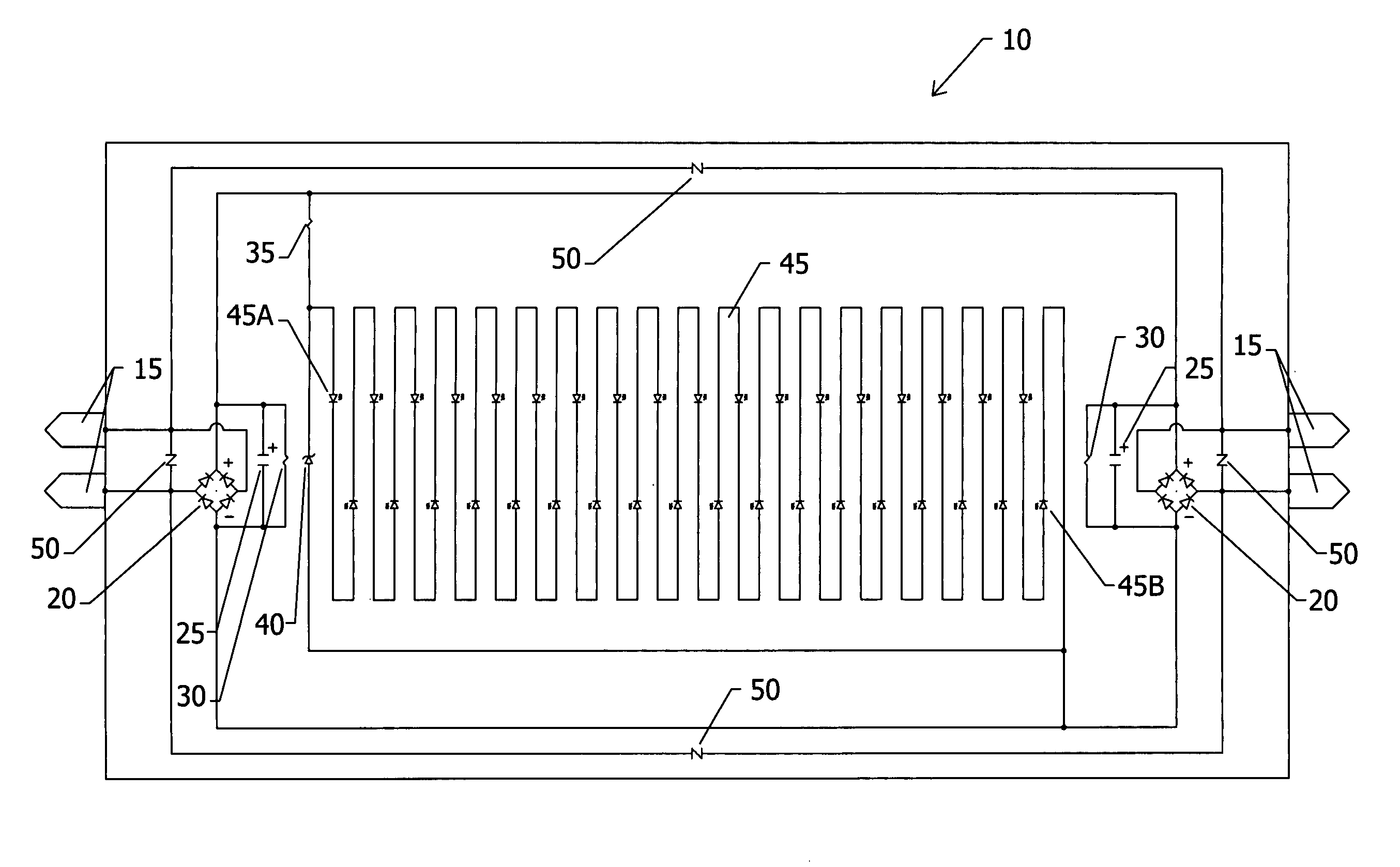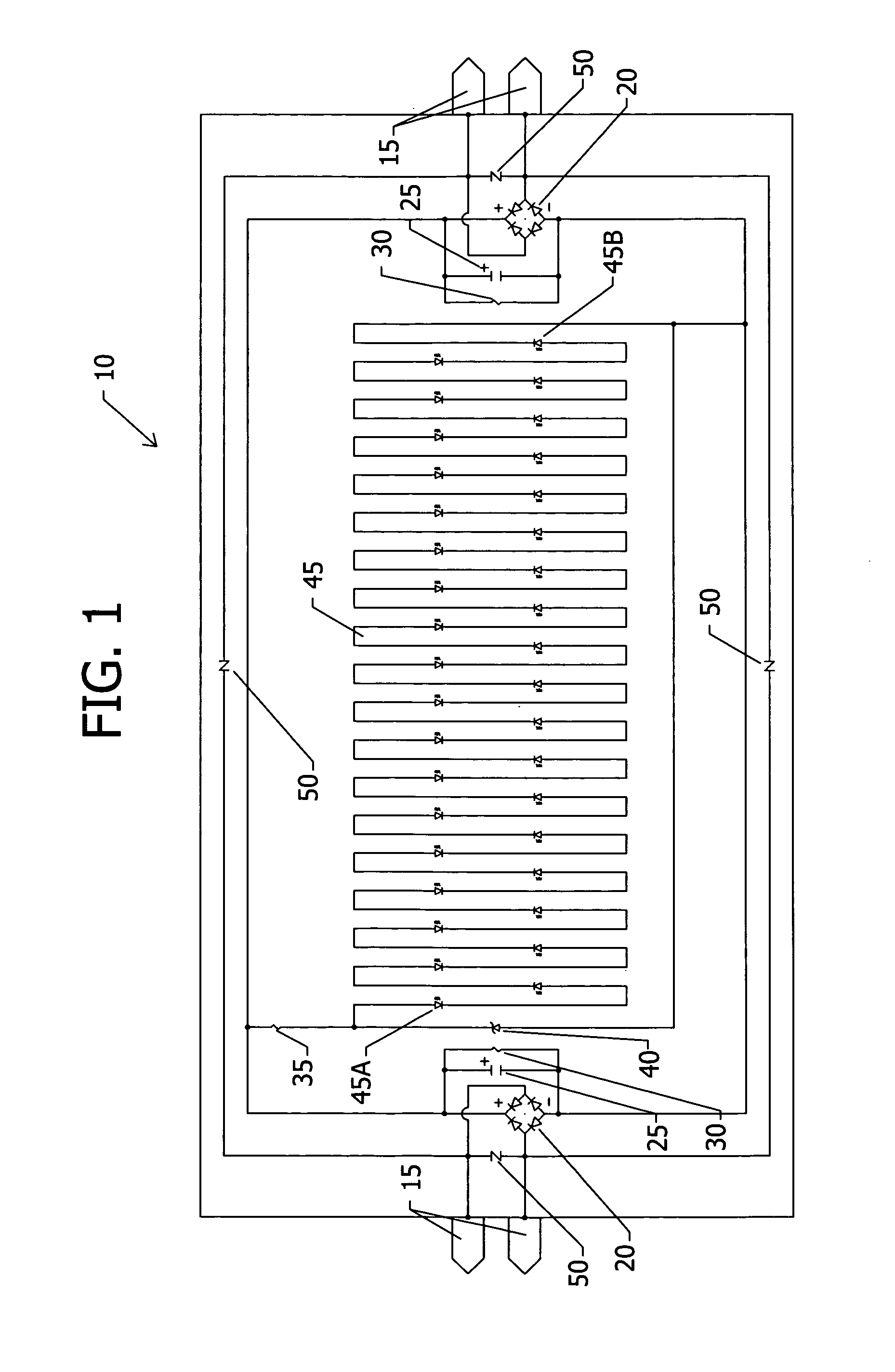Voltage regulating devices in LED lamps with multiple power sources
- Summary
- Abstract
- Description
- Claims
- Application Information
AI Technical Summary
Benefits of technology
Problems solved by technology
Method used
Image
Examples
first embodiment
[0059]FIG. 1 shows the present invention using a high power current limiting resistor 35 and a zener diode 40 as the main voltage regulating device to provide power to a series string of LEDs 45. LED lamp 10 is shown with bi-pins 15 on opposite ends of LED lamp 10. On both ends, bi-pins 15 are connected to the AC sides of AC-to-DC converters 20. The positive sides of AC-to-DC converters 20 are connected together. The positive sides are also filtered through capacitors 25 and bleeder resistors 30, and then passes through high power current limiting resistor 35 connected in series with zener diode 40 and series string of LEDs 45. Voltage reducing devices 50 may be connected to the bi-pins 15 of LED lamp 10.
[0060]The actual AC-to-DC converter 20 used is a full-wave bridge rectifier. The bridge rectifier circuit can consist of four separate silicon diodes or one bridge component. This bridge rectifier results in a rippled DC current and therefore serves as an example circuit only. A dif...
second embodiment
[0066]FIG. 2 shows the present invention using a high voltage regulator IC 75 as the main voltage regulating device to provide power to a series string of LEDs 125. LED lamp 60 is shown with bi-pins 65 on opposite ends of LED lamp 60. On both ends, bi-pins 65 are connected to the AC sides of AC-to-DC converters 70. The positive sides of AC-to-DC converters 70 are connected together. The positive sides of AC-to-DC converters 70 are also connected to a smoothing capacitor 80 and then to a resistor bridge consisting of resistor 85 and resistor 90. The positive sides of AC-to-DC converters 70 connect to one side of resistor 85 and to the input voltage side of high voltage regulator IC 75. The other side of resistor 85 is connected to one side of resistor 90 to base pin 100 of high voltage regulator IC 75 and to one side of capacitor 95. The other side of capacitor 95 connects to the negative sides of AC-to-DC converters 70 and to ground pin 105 of high voltage regulator IC 75. The outpu...
third embodiment
[0087]FIG. 5 shows the present invention using a high power current limiting resistor 280 and back-to-back zener diodes 285 as the main voltage regulating device to provide power to a series string of anti-parallel diode pairs 290. LED lamp 270 is shown with bi-pins 275 on opposite ends of LED lamp 270. Voltage reducing devices 300 may be connected to the bi-pins 275 of LED lamp 270.
[0088]The actual voltage reducing device 300 used is a varistor. A varistor or similar fusing device may be used to ensure that voltage is limited during power surges. The actual back-to-back zener diodes 285 can also be a back-to-back avalanche breakdown diodes or back-to-back TVS. Each anti-parallel diode pair 290 can consist of one diode and one LED, or both diodes can be LEDs. LED lamp 270 shows two LEDs in each anti-parallel diode pair 290. It will be noted that the LED lamp 270 will still operate with input power at only one end or across any two pins on bi-pins 275.
[0089]When ballast power is conn...
PUM
 Login to View More
Login to View More Abstract
Description
Claims
Application Information
 Login to View More
Login to View More - R&D
- Intellectual Property
- Life Sciences
- Materials
- Tech Scout
- Unparalleled Data Quality
- Higher Quality Content
- 60% Fewer Hallucinations
Browse by: Latest US Patents, China's latest patents, Technical Efficacy Thesaurus, Application Domain, Technology Topic, Popular Technical Reports.
© 2025 PatSnap. All rights reserved.Legal|Privacy policy|Modern Slavery Act Transparency Statement|Sitemap|About US| Contact US: help@patsnap.com



